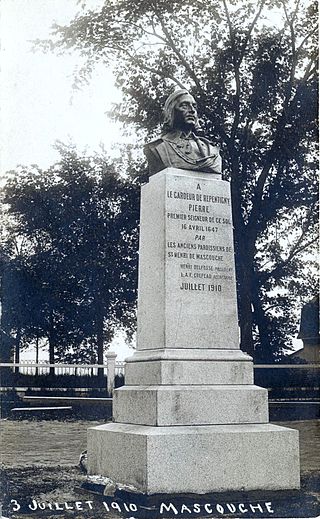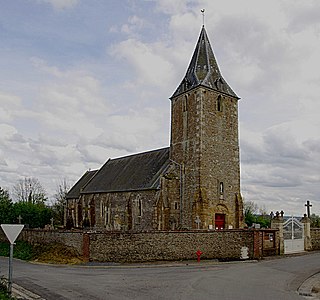Related Research Articles

Pierre Gaultier de Varennes, sieur de La Vérendrye was a French Canadian military officer, fur trader, and explorer. In the 1730s, he and his four sons explored the area west of Lake Superior and established trading posts there. They were part of a process that added Western Canada to the original New France territory that was centred along the Saint Lawrence basin.

This section of the Timeline of Quebec history concerns the events between the foundation of Quebec and establishment of the Sovereign Council.

This section of the Timeline of Quebec history concerns the events relating to the Quebec portion of New France between the establishment of the Sovereign Council and the fall of Quebec.
The Sovereign Council was a governing body in New France. It served as both Supreme Court for the colony of New France, as well as a policy-making body, though this latter role diminished over time. The council, though officially established in 1663 by King Louis XIV of France, was not created from whole cloth, but rather evolved from earlier governing bodies. As early as 1647, a council of three was created by the King. In 1648, this council was enlarged to include five members. The Sovereign Council came to be known as the Superior Council as early as June 16, 1703, when Louis XIV issued a royal edict referring to it as the Superior Council instead of its former name, and increasing the number of sitting Councilors from seven to twelve.

Events from the year 1709 in Canada.

Events from the year 1713 in Canada.

L'Assomption is an off-island suburb of Montreal, in southwestern Quebec, Canada on the L'Assomption River. It is the seat of the Regional County Municipality of L'Assomption. It is located on the outer fringes of the Montreal urban area.

Thury-Harcourt is a former commune in the Calvados department in the Normandy region in northwestern France. On 1 January 2016, it was merged into the new commune of Thury-Harcourt-le-Hom. The town is 24 kilometres (15 mi) south of Caen, in the Orne valley. It is part of Norman Switzerland, which attracts visitors for various sports and outdoor activities with its hilly terrain.

Jean-Baptiste-Antoine Ferland was a French Canadian historian.
Jacques Legardeur de Saint-Pierre was a Canadian colonial military commander and explorer who held posts throughout North America in the 18th century, just before and during the French and Indian War.

Nicolet is the county seat of Nicolet-Yamaska Regional County Municipality, Quebec, Canada. The population as of the Canada 2016 Census was 8,169. It is the seat of the Roman Catholic Diocese of Nicolet.

Gaspard-Joseph Chaussegros de Léry, his first name was also sometimes written Joseph-Gaspard. He was a military engineer and a political figure in Lower Canada. During the Seven Years' War he proved himself to be an outstanding officer and was one of only a few colonial officers held in high esteem by the Marquis de Montcalm.
Claude de Bermen de la Martinière was born in France and came to New France in 1662. Through marriage, he became the owner of a large seigneury and held a number of important positions throughout his time in Canada.
Jacques Leneuf de La Poterie was a fur merchant, businessman, seigneur, and co-founder and director of the Communauté des habitants, in the colony of Canada. He arrived in the colony in 1636 with the rest of his family, which included his elder brother Michel Leneuf, and together they, alongside their in-laws the Legardeurs, were the first of the French nobility to permanently settle in New France.
Jean-Paul Le Gardeur, sieur de Repentigny, was born in Ville-Marie on October 4, 1661, and died in 1738, was an explorer and lieutenant for New France, at the service of the King of the Kingdom of France. He was referred to as Saint-Pierre or Sieur de Saint-Pierre.

The Battle at Port-la-Joye was a battle in King George's War that took place with British against French troops and Mi'kmaq militia on the banks of present-day Hillsborough River, Prince Edward Island in the summer of 1746. French officer Jean-Baptiste Nicolas Roch de Ramezay sent French and Mi'kmaq forces to Port-la-Joye where they surprised and defeated a force of 200 Massachusetts militia in two British naval vessels that were gathering provisions for recently captured Louisbourg.
Charles Joseph d'Ailleboust des Muceaux was a soldier, merchant and judge in New France. He served as acting governor of Montreal from 1651 to 1653. He was a member of the Communauté des Habitants and of the Société Notre-Dame de Montréal.

Pierre Legardeur de Repentigny was a military person and seigneur in New France. He served as Governor Huault de Montmagny's lieutenant, as a director of the Communauté des habitants, and as admiral of the fleet for shipping in New France.

Thury-Harcourt-le-Hom is a commune in the department of Calvados, northwestern France. The municipality was established on 1 January 2016 by merger of the former communes of Thury-Harcourt, Caumont-sur-Orne, Curcy-sur-Orne, Hamars and Saint-Martin-de-Sallen.
Lingeer Ngoné Dièye was a Lingeer from the Serer Kingdom of Saloum, and ancestor of the Guedj maternal dynasty of Cayor and Baol. She was the wife of the 17th century Senegalese noble and Teigne Thié Yasin Demba Noudj Fall, and mother of Damel—Teigne Lat Soukabé Ngoné Fall who ruled Cayor and Baol from 1697 to 1719, the first Guedj to do so, after overthrowing the reigning maternal dynasty and installing his mother's matriclan. In usurping the throne, he committed fratricide by killing his paternal half-brother and took his throne.
References
- Lahaise, Robert (1979) [1969]. "Legardeur de Repentigny, Jean-Baptiste". In Hayne, David (ed.). Dictionary of Canadian Biography . Vol. II (1701–1740) (online ed.). University of Toronto Press.